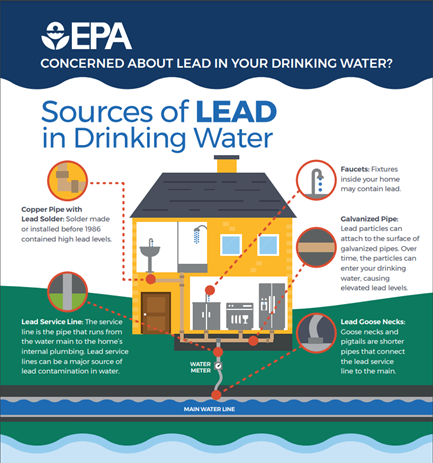Potential Progress on the Removal of Lead Water Pipes
Authored by Dylan Gerhart, Senior Project Manager
With new funds being proposed for infrastructure improvements on the federal level, there is a new push to remove and replace underground lead water pipes. It is worth taking a closer look at this ongoing issue and how we will be effected by these changes.
First off, a little background on lead. Lead is a toxic metal that can be harmful to human health even at low levels. Young children, infants, and fetuses are particularly vulnerable to lead because the adverse effects of lead poisoning occur at lower levels in children than in adults. A dose of lead that would have little effect on an adult can have a significant effect on a child.
Lead has been used widely throughout human history, and more recently there have been efforts to ban and then remove lead products from the everyday usage. Lead water pipes for example, have been used since the origin of plumbing, but became widespread in America in the late 1800s. Most cities used lead water pipes since they were cheaper and more durable than iron water pipes.
Concerns about lead poisoning linked to lead water pipes were raised as early as 1859 but little was done to slow their usage until the 1920s. In Chicago, lead water pipes were being installed as late as 1986. At which point, pipes with less than 8% lead-by-weight could still be used. In 2014 the allowable level of lead was lowered to 0.25%.

With lead pipes being used for such a long time, it comes as no surprise that there are an estimated 400,000 lead water lines in the City of Chicago, which accounts for about 80% of all homes in the city. When the city studied water samples collected from Chicago homes, lead was found in the drinking water of nearly 70% of homes, and roughly 30% of homes had concentrations above the EPA’s limit of 5 parts per billion.
The goal is now to remove these pipes. The city has looked at options from block grants to waiving fees for homeowners to remove the pipes themselves. Federal infrastructure packages also may contain funds for removal.
Hopefully, this progress continues and these pipes can be fully and safely removed. Until then, please contact us if you have any questions or concerns.
Sources
Basic Information About Lead Drinking Water
Chicago's Mayor Launches Lead Pipe Replacement Plan

